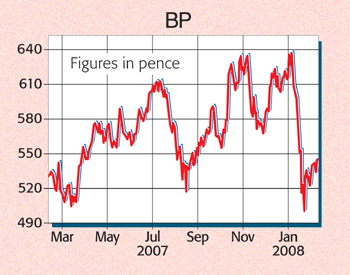
This oil stock has been battered by a series of problems in recent years. Yet it is historically less volatile than the rest of the market, and – thanks to buoyant energy prices – offers downside resilience in these uncertain times.
BP (BP/), tipped as a BUY by The Sunday Telegraph
BP is a classic “widows and orphans” stock for cautious investors who wish to own equities without taking too much risk. With a market capitalisation of more than £100bn, it’s one of the world’s largest oil firms, boasting estimated proven reserves of 17.7 billion barrels of oil equivalent (BOE) and annual turnover of $284bn. Over the past year its share price has fluctuated between 503p and 637p, but its beta is only 0.85, making it historically less volatile than the rest of the market.
With energy prices expected to stay high for the foreseeable future, at current levels it offers downside resilience in these uncertain times.
Admittedly, the group has been through the grinder over the past two years after a series of problems. It’s had pipeline leaks at its Prudhoe Bay field in Alaska, an explosion at its refinery in Texas and production delays at its Thunder Horse platform in the Gulf of Mexico. But a recovery seems to be underway.
The new chief executive, Tony Haywood, appointed in May, is shaking the group up. At last week’s results, the quarterly dividend was hiked by 25%, and 5,000 more job cuts were announced, which should slash overheads by about $1.5bn a year from 2009. Output is expected to grow this year after the commissioning of new wells in Angola, Trinidad and Egypt, on top of the long-awaited restart of the Thunder Horse facility.
Finally, last year BP replaced more than 100% of its hydrocarbon reserves and secured new access rights to fields in Oman, Libya and in Canada’s vast oil sands through a joint venture with Husky Energy. Production should rise from 3.8 million BOE a day last year to four million in 2009, and reach around 4.3 million by 2012. Other longer-term opportunities include Iraq, where BP is in dialogue with the local government about a plan to boost output at the huge Rumaila oil field on the border with Kuwait, which is estimated to contain around 18 billion BOE.
The group is expected to deliver underlying earnings per share of 59.5p in 2008 and pay a 24.7p dividend. That puts the stock on a p/e multiple of 9.8, with a chunky 4.5% yield, which is both well covered and higher than the 4.1% return available on five-year gilts.
So what do we need to watch out for? In its desire to grow production, BP is ramping up capital spending and focusing on more unstable regions, such as Russia, where it owns substantial stakes in TNK-BP and Rosneft. Exploration costs are also rising; its legal case relating to the Texas refinery explosion is still pending; and more delays could occur before resuming operations at Thunder Horse.
But on a sum-of-the-parts basis, the shares look cheap. Assuming a rough valuation of $15 per barrel for its proven reserves, then – after deducting $27.5bn of net debt and $9.2bn for the group’s pension deficit – an implied worth of £6.20 a share is derived. So at 550p, investors are getting the stock at around a 10% discount to fair value, plus obtaining the rest of its substantial assets (eg, drilling rights, refining, marketing, and renewable-energy operations) for free.
Recommendation: LONG-TERM BUY at 560p
• Paul Hill also writes a weekly share-tipping newsletter, Precision Guided Investments